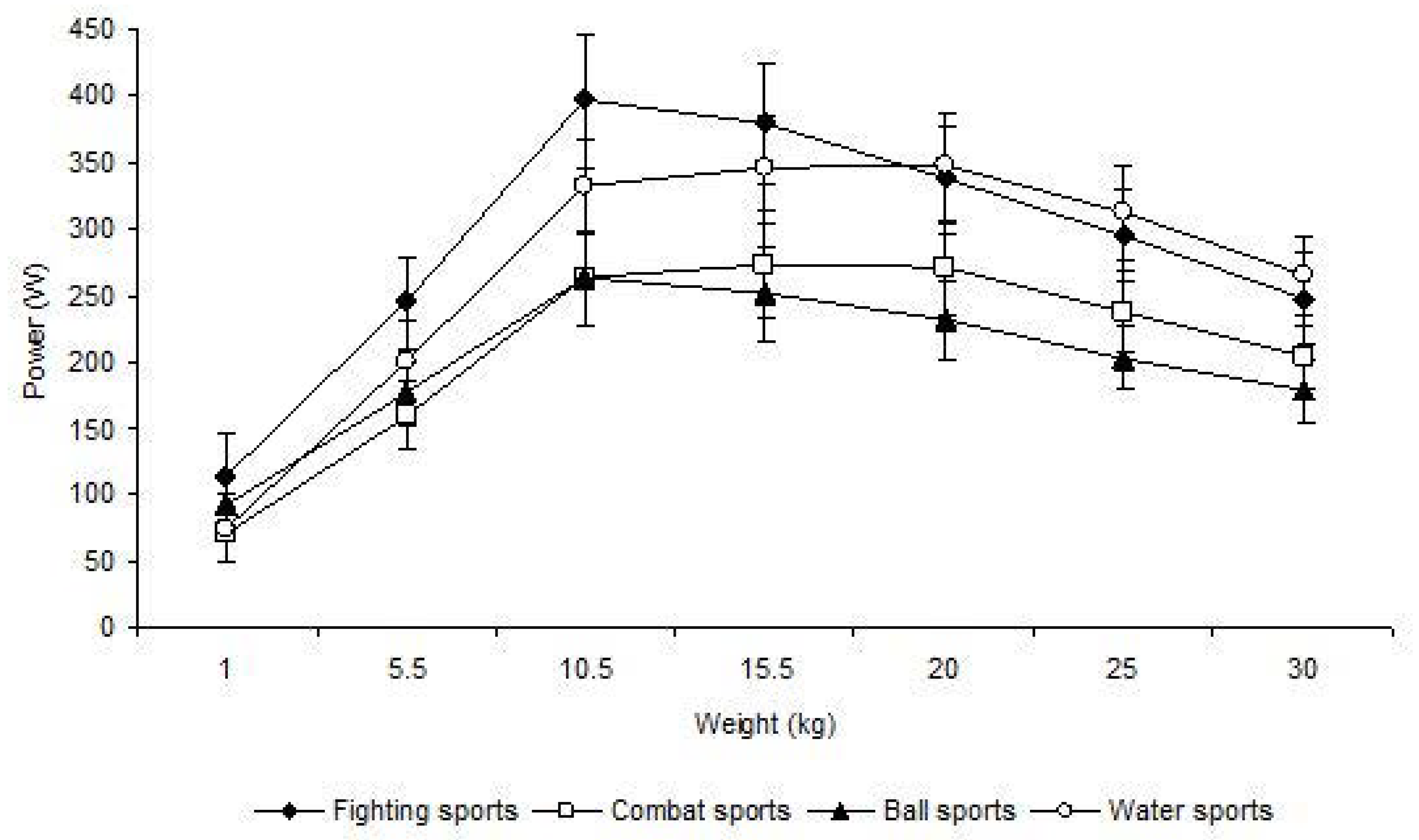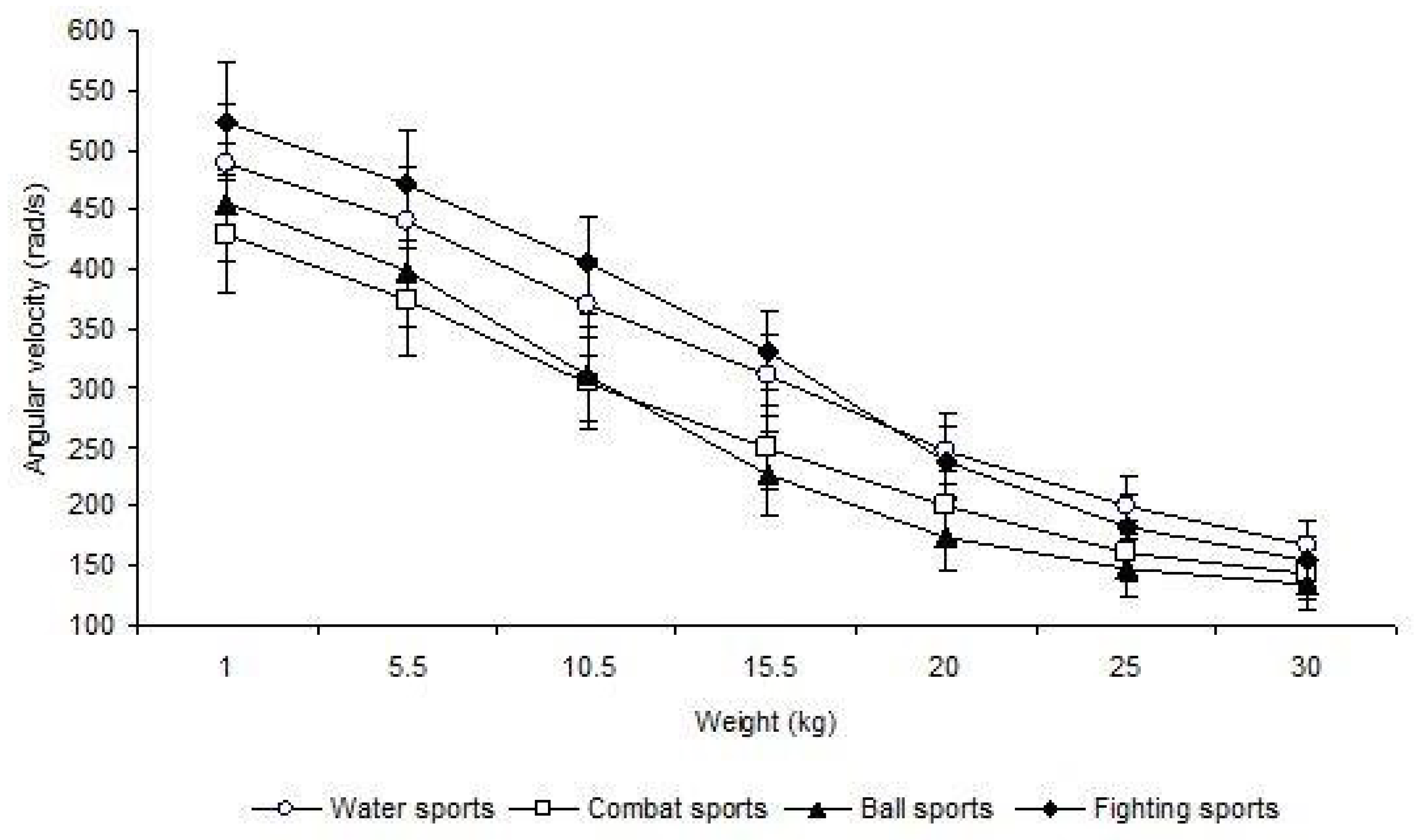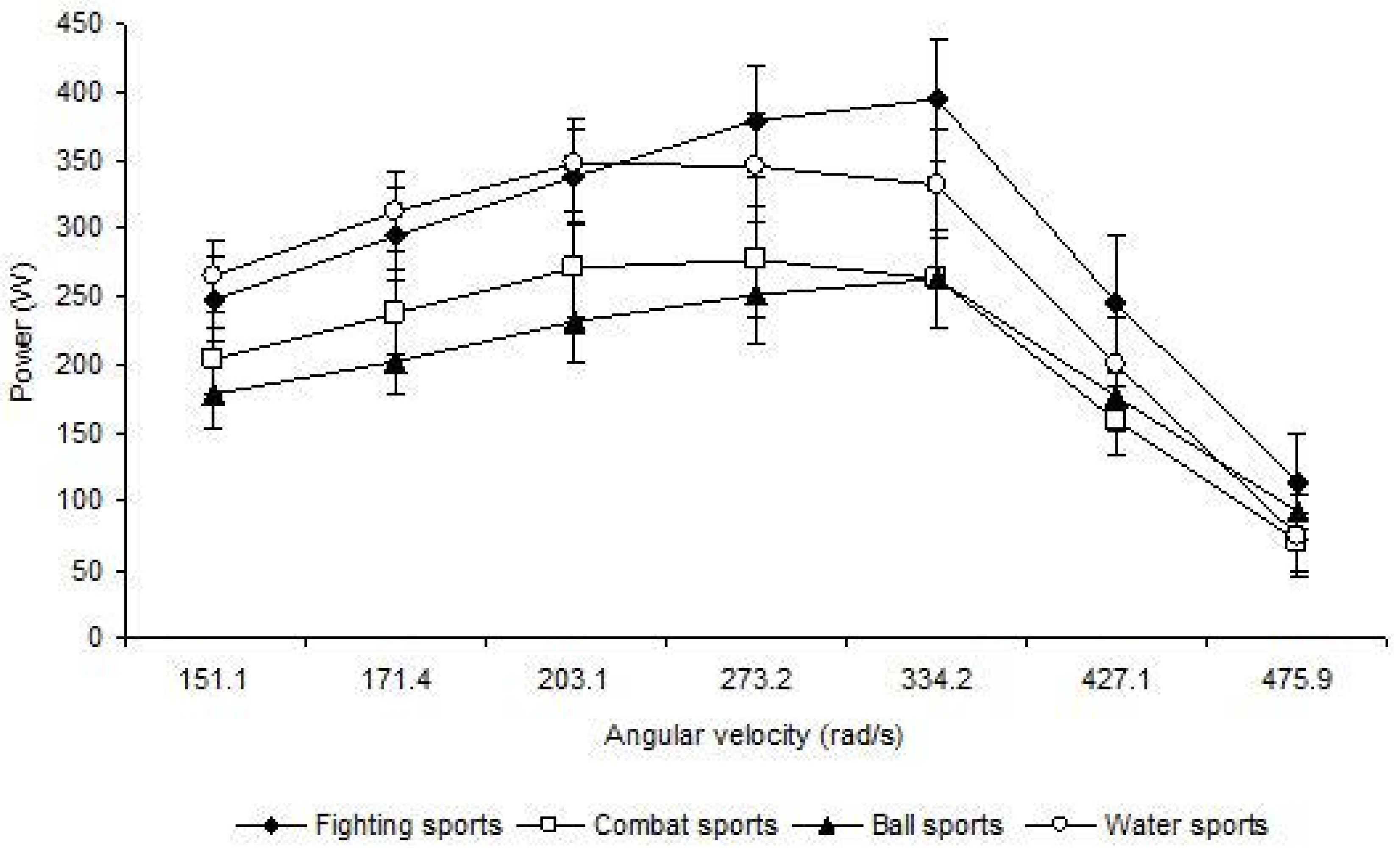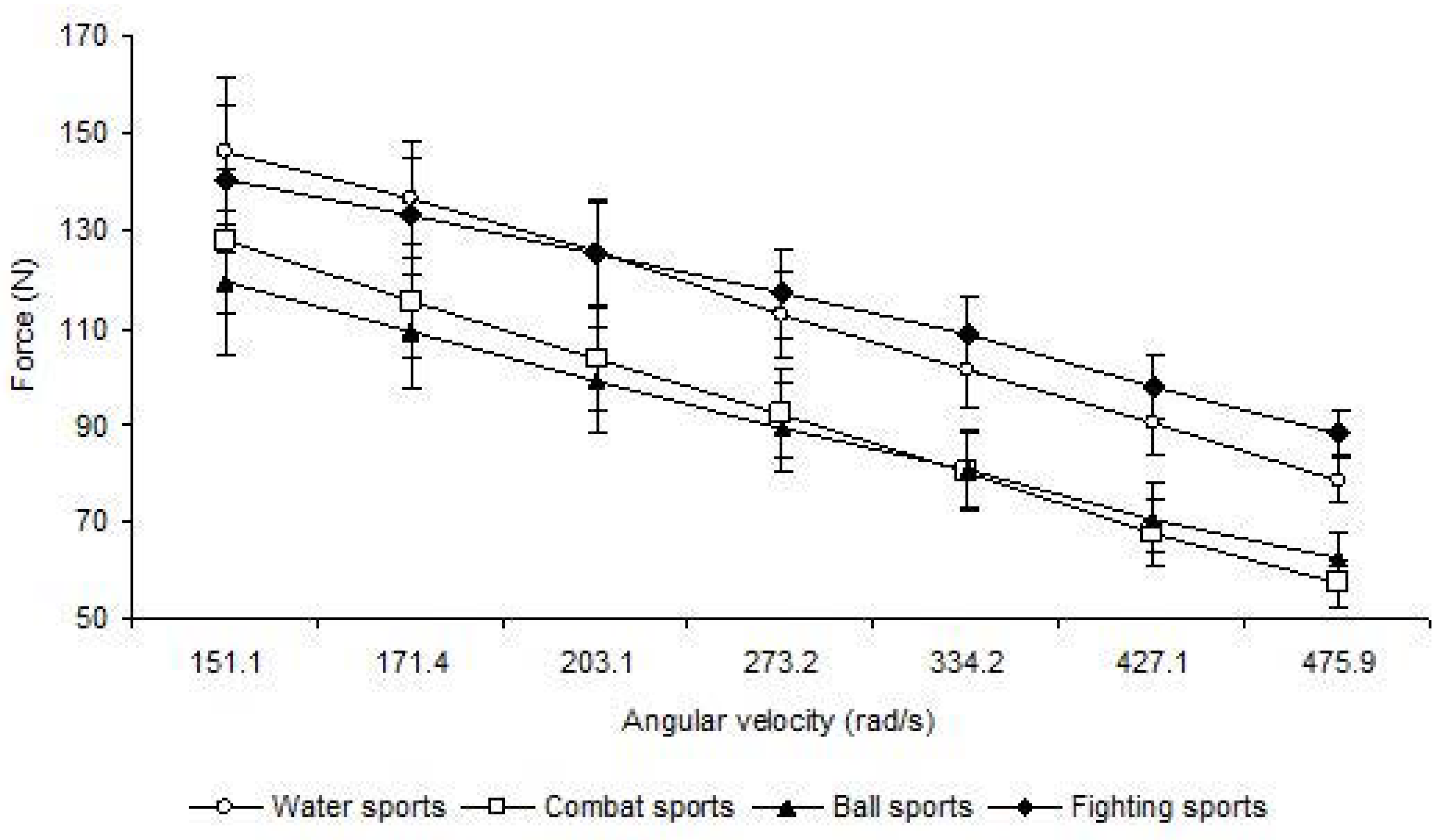Sport-Specific Differences in Power–Velocity–Force Profiling during Trunk Rotations at Different Loads
Abstract
Featured Application
Abstract
1. Introduction
2. Materials and Methods
2.1. Participants
2.2. Experimental Protocol
2.3. Statistical Analysis
3. Results
4. Discussion
5. Conclusions
Author Contributions
Funding
Conflicts of Interest
References
- Akuthota, V.; Nadler, S.F. Core strengthening. Arch. Phys. Med. Rehabil. 2004, 85, S86–S92. [Google Scholar] [CrossRef]
- Martín-Moya, R.; Ruiz-Montero, P.J. Key aspects on physical fitness and injury prevention programs in football: A narrative review. J. Sport Health Res. 2017, 9, 311–328. [Google Scholar]
- Barbado, D.; Barbado, L.C.; Elvira, J.L.L.; van Dieën, J.H.; Vera-Garcia, F.J. Sports-related testing protocols are required to reveal trunk stability adaptations in high-level athletes. Gait Posture 2016, 49, 90–96. [Google Scholar] [CrossRef]
- Behm, D.G.; Drinkwater, E.J.; Willardson, J.M.; Cowley, P.M. The use of instability to train the core musculature. Appl. Physiol. Nutr. Metab. 2010, 35, 91–108. [Google Scholar] [CrossRef] [PubMed]
- Keogh, J.W.L.; Aickin, S.E.; Oldham, A.R.H. Can common measures of core stability distinguish performance in a shoulder pressing task under stable and unstable conditions? J. Strength Cond. Res. 2010, 24, 422–429. [Google Scholar] [CrossRef] [PubMed]
- Palmer, T.G.; Uhl, T.L. Interday reliability of peak muscular power outputs on an isotonic dynamometer and assessment of active trunk control using the chop and lift tests. J. Athl. Train. 2011, 46, 150–159. [Google Scholar] [CrossRef]
- Andre, M.J.; Fry, A.C.; Heyrman, M.A.; Hudy, A.; Holt, B.; Roberts, C.; Vardiman, J.P.; Gallagher, P.M. A reliable method for assessing rotational power. J. Strength Cond. Res. 2012, 26, 720–724. [Google Scholar] [CrossRef] [PubMed]
- Zemková, E.; Cepková, A.; Uvaček, M.; Šooš, Ľ. A novel method for assessing muscle power during the standing cable wood chop exercise. J. Strength Cond. Res. 2017, 31, 2246–2254. [Google Scholar] [CrossRef] [PubMed]
- Talukdar, K.; Cronin, J.; Zois, J.; Sharp, A.P. The role of rotational mobility and power on throwing velocity. J. Strength Cond. Res. 2015, 29, 905–911. [Google Scholar] [CrossRef][Green Version]
- Nesser, T.W.; Huxel, K.C.; Tincher, J.L.; Okada, T. The relationship between core stability and performance in division I football players. J. Strength Cond. Res. 2008, 22, 1750–1754. [Google Scholar] [CrossRef]
- Sato, K.; Mokha, M. Does core strength training influence running kinetics, lower-extremity stability, and 5000-M performance in runners? J. Strength Cond. Res. 2009, 23, 133–140. [Google Scholar] [CrossRef] [PubMed]
- Scibek, J.S. The Effect of Core Stabilization Training on Functional Performance in Swimming. Ph.D. Thesis, University of North Carolina, Chapel Hill, NC, USA, 1999. [Google Scholar]
- Stanton, R.; Reaburn, P.R.; Humphries, B. The effect of short-term Swiss ball training on core stability and running economy. J. Strength Cond. Res. 2004, 18, 522–528. [Google Scholar] [CrossRef] [PubMed]
- Tse, M.A.; McManus, A.M.; Masters, R.S. Development and validation of a core endurance intervention program: Implications for performance in college-age rowers. J. Strength Cond. Res. 2005, 19, 547–552. [Google Scholar] [CrossRef] [PubMed]
- Brown, E.W.; Abani, K. Kinematics and kinetics of the dead lift in adolescent power lifters. Med. Sci. Sports Exerc. 1985, 17, 554–566. [Google Scholar] [CrossRef] [PubMed]
- Thelen, D.G.; Ashton-Miller, J.A.; Schultz, A.B. Lumbar muscle activities in rapid three-dimensional pulling tasks. Spine 1996, 21, 605–613. [Google Scholar] [CrossRef] [PubMed]
- Stodden, D.F.; Fleisig, G.S.; McLean, S.P.; Lyman, S.L.; Andrews, J.R. Relationship of pelvis and upper torso kinematics to pitched baseball velocity. J. Appl. Biomech. 2001, 17, 164–172. [Google Scholar] [CrossRef]
- Cholewicki, J.; VanVliet, J.J. 4th. Relative contribution of trunk muscles to the stability of the lumbar spine during isometric exertions. Clin. Biomech. 2002, 17, 99–105. [Google Scholar] [CrossRef]
- Ellenbecker, T.S.; Roetert, E.P. An isokinetic profile of trunk rotation strength in elite tennis players. Med. Sci. Sports Exerc. 2004, 36, 1959–1963. [Google Scholar] [CrossRef]
- Abt, J.P.; Smoliga, J.M.; Brick, M.J.; Jolly, J.T.; Lephart, S.M.; Fu, F.H. Relationship between cycling mechanics and core stability. J. Strength Cond. Res. 2007, 21, 1300–1304. [Google Scholar] [CrossRef]
- Aguinaldo, A.L.; Buttermore, J.; Chambers, H. Effects of upper trunk rotation on shoulder joint torque among baseball pitchers of various levels. J. Appl. Biomech. 2007, 23, 42–51. [Google Scholar] [CrossRef]
- Lindsay, D.M.; Horton, J.F. Trunk rotation strength and endurance in healthy normals and elite male golfers with and without low back pain. N. Am. J. Sports Phys. Ther. 2006, 1, 80–88. [Google Scholar] [PubMed]
- Suter, E.; Lindsay, D.M. Back muscle fatigability is associated with knee extensor inhibition in subjects with low back pain. Spine 2001, 26, E361–E366. [Google Scholar] [CrossRef] [PubMed]
- Zemková, E.; Jeleň, M.; Zapletalová, L.; Hamar, D. Muscle power during standing and seated trunk rotations with different weights. Sport Mont. 2017, 15, 17–23. [Google Scholar] [CrossRef]
- Zemková, E.; Jeleň, M.; Ollé, G.; Chren, M.; Olej, P.; Štefanovský, M.; Zapletalová, L.; Žiška, J.; Hamar, D. Mean power and velocity in acceleration phase of trunk rotation in athletes with different explosive force production capacity. In Proceedings of the 19th Annual Congress of the European College of Sport Science, Amsterdam, The Netherlands, 2–5 July 2014; p. 268. [Google Scholar]
- Zemková, E.; Jeleň, M.; Ollé, G.; Hamar, D. Mean velocity of trunk rotation discriminates athletes with different sport-related demands. Eur. J. Sports Med. 2013, 1, 216. [Google Scholar]
- Cohen, J. A power primer. Psychol. Bull. 1992, 112, 155–159. [Google Scholar] [CrossRef]
- Shinkle, J.; Nesser, T.W.; Demchak, T.J.; McMannus, D.M. Effect of core strength on the measure of power in the extremities. J. Strength Cond. Res. 2012, 26, 373–380. [Google Scholar] [CrossRef]
- Watkins, R.G.; Uppal, G.S.; Perry, J.; Pink, M.; Dinsay, J.M. Dynamic electromyographic analysis of trunk musculature in professional golfers. Eur. J. Appl. Physiol. Occup. Physiol. 1996, 24, 535–538. [Google Scholar] [CrossRef]
- Poór, O.; Zemková, E. The effect of training in the preparatory and competitive periods on trunk rotational power in canoeists, ice-hockey players, and tennis players. Sports 2018, 6, 113. [Google Scholar] [CrossRef]
- Tihanyi, J.; Apor, P.; Fekete, G. Force-velocity-power characteristics and fiber composition in human knee extensor muscles. Eur. J. Appl. Physiol. Occup. Physiol. 1982, 48, 331–343. [Google Scholar] [CrossRef]
- Sahrmann, A.S. Diagnosis and Treatment of Movement Impairment Syndrome; Mosby Inc.: St Louis, MO, USA, 2002. [Google Scholar]
- Earp, J.E.; Kraemer, W.J. Medicine ball training implications for rotational power sports. Strength Cond. J. 2010, 32, 20–25. [Google Scholar] [CrossRef]
- Putnam, C.A. Sequential motions of body segments in striking and throwing skills: Descriptions and explanations. J. Biomech. 1993, 26, 125–135. [Google Scholar] [CrossRef]
- Wagner, H.; Pfusterschmied, J.; Tilp, M.; Landlinger, J.; von Duvillard, S.P.; Müller, E. Upper-body kinematics in team-handball throw, tennis serve, and volleyball spike. Scand. J. Med. Sci. Sports 2014, 24, 345–354. [Google Scholar] [CrossRef] [PubMed]
- Serrien, B.; Baeyens, J.-P. Systematic review and meta-analysis on proximal-to-distal sequencing in team handball: Prospects for talent detection? J. Hum. Kinet. 2018, 63, 9–21. [Google Scholar] [CrossRef] [PubMed]




| Groups of Athletes | n (1) | Age (Years) | Height (cm) | Body Mass (kg) |
|---|---|---|---|---|
| Boxers and Thai boxers | 12 | 22.3 ± 4.7 | 183.6 ± 8.5 | 83.8 ± 10.0 |
| Canoeists and kayakers | 19 | 24.7 ± 3.6 | 178.6 ± 6.5 | 72.7 ± 6.4 |
| Golfers | 15 | 26.1 ± 4.2 | 180.6 ± 9.3 | 81.4 ± 13.6 |
| Hockey players | 20 | 23.5 ± 3.0 | 184.6 ± 7.7 | 83.1 ± 9.9 |
| Judo competitors | 14 | 21.9 ± 2.7 | 177.3 ± 6.8 | 75.6 ± 7.5 |
| Karate and tae kwon do competitors | 27 | 22.9 ± 2.8 | 179.1 ± 6.0 | 76.3 ± 8.2 |
| Tennis players | 17 | 23.2 ± 3.3 | 181.4 ± 6.5 | 73.9 ± 10.7 |
| Wrestlers | 9 | 25.4 ± 3.6 | 177.9 ± 8.1 | 80.0 ± 8.9 |
| Mean Power in the Acceleration Phase of Trunk Rotations at Different Weights (W) | ||||||
|---|---|---|---|---|---|---|
| Groups of Athletes | 1 kg | 5.5 kg | 10.5 kg | 15.5 kg | 20 kg | |
| Boxers and Thai boxers | 130.1 ± 17.8 | 276.2 ± 30.1 | 445.3 ± 43.2 | 436.4 ± 41.8 | 423.5 ± 44.1 | |
| Canoeists and kayakers | 75.1 ± 9.2 | 201.3 ± 20.9 | 332.6 ± 25.6 | 345.3 ± 30.4 | 346.9 ± 36.1 | |
| Golfers | 60.4 ± 8.4 | 118.6 ± 13.2 | 169.9 ± 19.5 | 136.2 ± 16.6 | 107.3 ± 14.2 | |
| Hockey players | 120.7 ± 14.5 | 236.3 ± 27.6 | 393.7 ± 34.7 | 407.0 ± 41.5 | 404.0 ± 38.1 | |
| Judo competitors | 71.0 ± 9.0 | 160.7 ± 19.3 | 254.2 ± 25.2 | 266.4 ± 26.3 | 252.3 ± 27.0 | |
| Karate and tae kwon do competitors | 99.0 ± 11.9 | 213.5 ± 22.8 | 348.1 ± 35.4 | 321.3 ± 29.9 | 271.5 ± 26.8 | |
| Tennis players | 95.7 ± 10.1 | 173.9 ± 20.0 | 227.3 ± 22.6 | 213.2 ± 23.7 | 183.9 ± 21.9 | |
| Wrestlers | 68.8 ± 8.9 | 158.5 ± 18.9 | 271.7 ± 28.5 | 286.1 ± 30.3 | 288.7 ± 27.9 | |
| Mean Power in the Acceleration Phase of Trunk Rotations at Different Weights (W) | ||||||
| Groups of Athletes | 25 kg | 30 kg | 35 kg | 40 kg | 45 kg | 50 kg |
| Boxers and Thai boxers | 398.8 ± 35.7 | 371.0 ± 33.4 | 350.9 ± 34.1 | 327.3 ± 29.8 | 290.1 ± 26.3 | 250.5 ± 25.0 |
| Canoeists and kayakers | 312.7 ± 28.0 | 248.3 ± 24.7 | 201.7 ± 23.4 | 155.0 ± 18.1 | ||
| Golfers | 94.2 ± 11.1 | 85.6 ± 10.5 | ||||
| Hockey players | 365.6 ± 33.2 | 340.8 ± 30.9 | 332.8 ± 31.9 | 310.0 ± 27.7 | 270.0 ± 26.9 | |
| Judo competitors | 214.4 ± 24.9 | 180.0 ± 20.9 | 155.0 ± 17.3 | 110.0 ± 13.1 | ||
| Karate and tae kwon do competitors | 232.3 ± 22.7 | 200.3 ± 20.5 | 165.0 ± 18.8 | |||
| Tennis players | 149.9 ± 18.4 | 138.6 ± 16.3 | 109.1 ± 15.0 | |||
| Wrestlers | 263.1 ± 27.4 | 227.7 ± 26.6 | 190.5 ± 23.5 | 140.0 ± 19.9 | ||
Publisher’s Note: MDPI stays neutral with regard to jurisdictional claims in published maps and institutional affiliations. |
© 2020 by the authors. Licensee MDPI, Basel, Switzerland. This article is an open access article distributed under the terms and conditions of the Creative Commons Attribution (CC BY) license (http://creativecommons.org/licenses/by/4.0/).
Share and Cite
Zemková, E.; Poór, O.; Jeleň, M. Sport-Specific Differences in Power–Velocity–Force Profiling during Trunk Rotations at Different Loads. Appl. Sci. 2020, 10, 8366. https://doi.org/10.3390/app10238366
Zemková E, Poór O, Jeleň M. Sport-Specific Differences in Power–Velocity–Force Profiling during Trunk Rotations at Different Loads. Applied Sciences. 2020; 10(23):8366. https://doi.org/10.3390/app10238366
Chicago/Turabian StyleZemková, Erika, Oliver Poór, and Michal Jeleň. 2020. "Sport-Specific Differences in Power–Velocity–Force Profiling during Trunk Rotations at Different Loads" Applied Sciences 10, no. 23: 8366. https://doi.org/10.3390/app10238366
APA StyleZemková, E., Poór, O., & Jeleň, M. (2020). Sport-Specific Differences in Power–Velocity–Force Profiling during Trunk Rotations at Different Loads. Applied Sciences, 10(23), 8366. https://doi.org/10.3390/app10238366






